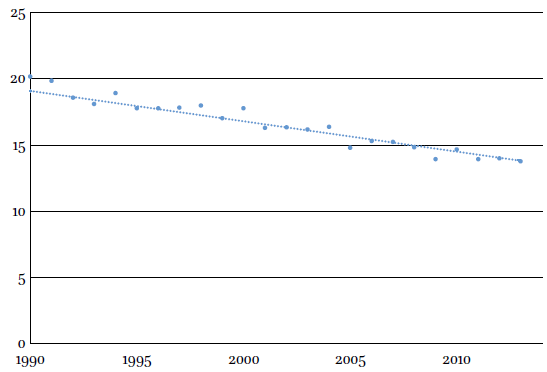#SciDoom The Field of Science blog network is having a ‘We’re all doomed’ jamboree. What follows is my contribution to this blogging meme. Check out the other blogs on the FoS homepage to see what they have to say!
In David Sloan Wilson’s forthcoming book “The Neighborhood Project”, he tells the story of Daphne Fairbairn, an evolutionary biologist who studies water striders (those small bugs that skit around on the surface of still water – they’re also known as pond skaters).
 |
| The Dugger family – Gawd bless ’em! |
Fairbairn wanted to understand the evolutionary pressures that drove the size of these wee beasties, and in a series of meticulous experiments (including catching and re-catching all the striders on a stretch of water over several life cycles), she was able to prove that there are two forces working in opposition. Small bugs aren’t as fertile, but they live a long time. Big bugs die fast, but have more luck on the fecundity front, while they are still alive. The perfect size is a play off between the two pressures.
Don’t worry, we aren’t all going to be killed by giant water striders! But what this does illustrate nicely is that evolution works on an interplay between survival and reproduction. Having a high potential for reproduction doesn’t help you if you die before you can reproduce.
And this applies to humans too, of course. Which brings me to the point of my post – which is that the ‘fitness landscape for humans is rapidly changing in ways that will, I think, have radical consequences for our future.
Consider this. Throughout most of human history, reclusive, introverted cult groups have had a very short life expectancy. That’s not because they didn’t exist – take the Paulicians, for example. No, the main problem was that when they inevitably rubbed up against more normal, open society, they tended to get killed.
That’s because, when it comes to warfare, large compromise-based alliances of pragmatic individuals usually win out. Inflexible fundamentalism is a bad cultural strategy. Even the most successful of these reclusive cults – orthodox Jews – have only clung on in the face of repeated, murderous pogroms.
These days, however, savage and indiscriminate murder of people with deviant beliefs is generally frowned upon.
Then too consider the effects of child mortality. It’s no good having lots of children if they don’t live to reproductive age. You would be better off having few children, and investing more in each. But modern society keeps almost all children alive. Food is plentiful, and so even the poorest people in wealthy nations can feed their kids enough to keep them alive, at least until they reach reproductive age.
Put these two facts together, and it’s very easy to see what will happen. Human society was once, like water striders, regulated by two competing pressures – the pressure to reproduce, but also the pressure to survive long enough to reproduce (and then to keep your children alive).
One of these pressures has now been removed. All that now matters is the numbers of children that an individual churns out in their life. And who churns out the most children? Well, it’s the fringe, reclusive, fundamentalist cults, of course.
Besides their very high fertility, these cults are also characterised by their low loss to attrition. Sure, some people do leave, but on the whole access to the outside world is restricted and discouraged, which it makes it a brave individual indeed who will take the plunge.
And the ones that do leave are the most open-minded, enquiring minds. So what you have is an ongoing culture-gene interaction, in which those who are the most rigid-thinking, the most introverted, and the most fearful of other cultures, remain behind – embedded in a culture that propels them to dizzying levels of fertility.
The consequences were made clear by Eric Kaufman in his recent book, Shall the Religious Inherit the Earth. Freed from historical constraints limiting their numbers, what in historical contexts would have been short-lived fringe cults are now expanding at an exponential rate. The classic example is the Amish, whose numbers have shot up from 5,000 to 250,000 over the past century.
Extrapolate these trends to the not-to-distant future, and it’s clear what will happen. If you want a vision of the future, imagine a normal, liberal society comprising ordinary religious and non-religious living in mostly urban areas, embedded in a population comprising mostly of disparate cults bred and trained from birth to be dogmatic, insular and narrow-minded.
These cult groups will expand to consume an ever greater share of land and other resources. Eventually, they will come into conflict with each other. But this won’t be a conflict like the ordinary wars of old. It will be characterised by utter mutual incomprehension and immutable beliefs. The crusades and the Nazi-Communist conflict will seem tame in comparison.
Perhaps you think I’m being melodramatic. Well, perhaps. There are many variables at work here, and something other than war will come into play to normalise the current imbalance of reproduction. I can’t think what that would be, though!
 This article by Tom Rees was first published on Epiphenom. It is licensed under Creative Commons.
This article by Tom Rees was first published on Epiphenom. It is licensed under Creative Commons.














